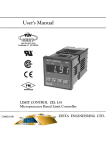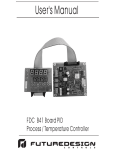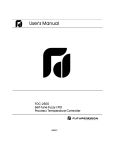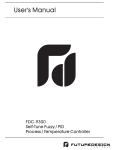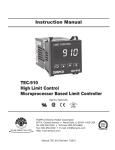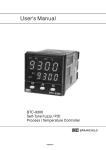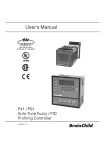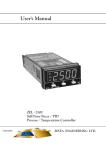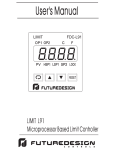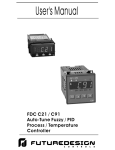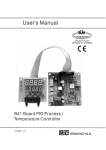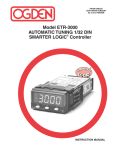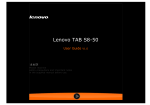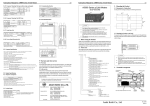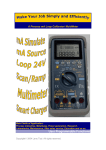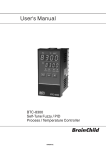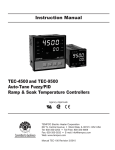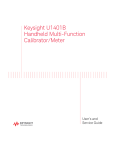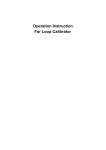Download UM0L411B
Transcript
User's Manual DIN EN ISO 9001 Certificate: 01 100 98505 UL R LISTED R APPROVED LIMIT CONTROL L41 Microprocessor Based Limit Controller UM0L411B Warning Symbol The Symbol calls attention to an operating procedure, practice, or the like, which, if not correctly performed or adhered to, could result in personal injury or damage to or destruction of part or all of the product and system. Do not proceed beyond a warning symbol until the indicated conditions are fully understood and met. Use the Manual Installers Read Chapter 1, 2 System Designer Read All Chapters Expert User Read Page 12 NOTE: It is strongly recommended that a process should incorporate a LIMIT CONTROL like L41 which will shut down the equipment at a preset process condition in order to preclude possible damage to products or system. Information in this user's manual is subject to change without notice. This manual is applicable for the products with software version 11 and later version. Copyright a September 2007, The Brainchild Corporation, all rights reserved. No part of this publication may be reproduced, transmitted, transcribed or stored in a retrieval system, or translated into any language in any form by any means without the written permission of the Brainchild Corporation. 2 UM0L411A Contents Page No Chapter 1 Overview 5 6 7 8 14 1-5 Menu Overview 1-6 Limit Control Operation 15 1-7 Parameter Descriptions 18 1-1 General 1-2 Ordering Code 1-3 Programming Port 1-4 Keys and Display Chapter 2 Installation 2-1 Unpacking 2-2 Mounting 2-3 Wiring Precautions 2-4 Power Wiring 2-5 Sensor Installation Guidelines 2-6 Thermocouple Input Wiring 2-7 RTD Input Wiring 2-8 Linear DC Input Wiring 2-9 Event Input Wiring 2-10 Output 1 Wiring 2-11 Output 2 Wiring 2-12 RS-485 2-13 RS-232 2-14 Retransmission 24 24 25 Page No 3-3 Set point Range 3-4 PV Shift 3-5 Digital Filter 40 41 41 42 44 44 3-6 Process Alarms 3-7 Data Communication 3-8 PV Retransmission 3-9 Signal Conditioner DC Power Supply 3-10 Remote Reset 3-11 Remote Lock 3-12 Limit Annunciator 45 46 46 47 47 3-13 Reference Data 27 Chapter 4 Applications 48 28 Chapter 5 Calibration 28 29 31 32 33 34 36 37 38 49 Chapter 6 Specifications 54 Chapter 7 Modbus Communications 59 Appendix A-1 Error codes 68 Chapter 3 Programming 3-1 Process Input 3-2 Limit Control 39 40 UM0L411A 3 Figures & Tables Page No Figure 1-1 Access Hole Overview 7 Figure 1-2 Front Panel Display 9 Figure 1-3 Power Up Sequence 12 Figure 1-4 High Limit Operation 15 Figure 1-5 Low Limit Operation 16 Figure 1-6 High/Low Limit Operation 17 Figure 2-1 Mounting Diagram 25 Figure 2-2 Lead Termination 26 Figure 2-3 Rear Terminal Connection Diagram 26 Figure 2-4 Power Supply Connections 27 Figure 2-5 Thermocouple Input Wiring 29 Figure 2-6 RTD Input Wiring 30 Figure 2-7 Linear Voltage Input Wiring 31 Figure 2-8 Linear Current Input Wiring 31 Figure 2-9 Event Input Wiring 32 Figure 2-10 Output 1 Wiring 33 Figure 2-11 Output 2 Wiring 34 Figure 2-12 RS-485 Wiring 36 Figure 2-13 RS-232 Wiring 37 Figure 2-14 Configuration of RS-232 cable 37 Figure 2-15 Retransmission Wiring 38 Figure 3-1 Conversion Curve for Linear Type Process Value 39 Figure 3-2 Filter Characteristics 41 Figure 3-3 Normal Process Alarm 43 Figure 3-4 Latching Process Alarm 43 Figure 3-5 DC Power Supply Application 45 Figure 3-6 Remote Reset Application 46 Figure 3-7 Remote Lock Application 46 Figure 4-1 Over Temperature Protection with Remote Reset 48 Figure 5-1 Flowchart for Manual Calibration 50 Figure 5-2 Cold Junction Calibration Setup 51 Figure 5-3 RTD Calibration 52 Table 1-1 DIP Switch Configuration Table 1-2 Display Form of Characters Table 6-1 Input Characteristics 4 UM0L411A 7 10 55 Chapter 1 Overview 1-1 General The limit control L41 is an over temperature protection or a high limit safety device with a latching output, that removes power in an abnormal condition during the process is higher than the high limit set point or lower than the low limit set point. The unit is powered by 11-26 or 90-250 VDC/VAC supply, incorporating a 3 amp. form C relay for limit control, an universal input which is fully programmable for PT100, thermocouple types J, K, T, E, B, R, S, N, L, C, P and 0~60mV, an option port available for one of the following functions: RS-232, RS-485 communication interface and Retransmission. Alternative output options include SSR drive and triac . The input signal is digitized by using a 18-bit A to D converter. Its fast sampling rate (5 times/second) allows the L41 to control fast process such as pressure and flow. Digital communication RS-485 is available as an additional option. This option allows L41 to be integrated with supervisory control system. An alarm output is another option. A variety of alarm function and alarm mode can be programmed for a specific application. The DC power supply output option is used for an external sensor or transmitter. The standard event input can be programmed for remote reset or remote lock signal input. The limit annunciator can be used to control an alarm buzzer. Three kinds of method can be used to program L41. 1. use keys on front panel to program the unit manually, 2. Use a PC and setup software to program the unit via RS-485 port and 3. Use a pc and configuration software to program the unit via programming port. High accuracy, maximum flexibility, fast response and user friendly are the main features of L41. UM0L411A 5 1-2 Ordering Code L41 1 2 3 4 5 6 7 8 Standard leave blank Special Order AA-ZZ Power Input 4: 90-250 VAC, 47-63 HZ 5: 11 - 26 VAC or VDC, SELV, Limited Energy Options 0: IP50 standard 1: IP65 water resistant rubber installed Communication 0:None 1: RS-485 interface 2: RS-232 interface 3: Retransmit 4-20mA/0-20mA 4: Retransmit 1-5V/0-5V 5: Retransmit 0-10V 9: Special Order Signal Input 1: Standard Input Thermocouple: J, K, T, E, B, R, S, N, L, C, P RTD: PT100 DIN, PT100 JIS mV: 0~60 mV 2: Voltage: 0-1 V 3: Voltage : 0-10 V 4: Current: 0-20mA 5: Voltage : 0-5 V 9: Special Order Output 1 0: None 1: Form C relay rated 2A/240VAC 2: Pulsed voltage to drive SSR, 5V/30mA 6: Triac Output 1A / 240VAC,SSR C: Pulsed voltage to drive SSR, 14V/40mA 9: Special order Output 2 0: None 1: Form C Relay 2A/240VAC 2: Pulsed voltage to drive SSR, 5V / 30mA 6: Triac Output, 1A / 240VAC, SSR 7: Isolated 20V / 25mA DC Output Power Supply 8: Isolated 12V / 40 mA DC Output Power Supply 9: Isolated 5V / 80mA DC Output Power Supply C: Pulsed voltage to drive SSR, 14V/40mA H: Special order Accessories OM94-6 = Isolated 1A/240VAC Triac Output Module (SSR) OM94-7 = 14V/40mA SSR Drive Module DC94-1 = Isolated 20V / 25mA DC Output Power Supply DC94-2 = Isolated 12V / 40mA DC Output Power Supply DC94-3 = Isolated 5V / 80mA DC Output Power Supply CM94-1 = Isolated RS-485 Interface Module CM94-2 = Isolated RS-232 Interface Module CM94-3 = Isolated 4-20mA / 0-20mA Retransmission Module CM94-4 = Isolated 1-5V / 0-5V Retransmission Module CM94-5 = Isolated 0-10V Retransmission Module CC91-3 = Programming port cable for L41 6 UM0L411B Related Products SNA10A = Smart Network Adaptor for Third Party Software, Converts 255 channels of RS-485 or RS-422 to RS-232 Network SNA12A = Smart Network Adaptor for programming port to RS-232 interface. BC-Set = Configuration Software Standard model without option : L41-411000 1-3 Programming Port and DIP Switch Rear Terminal Front Panel ON DIP 1234 Figure 1.1 Access Hole Overview Access Hole The programming port is used to connect to SNA12A for automatic programming, also can be connected to ATE system for automatic testing & calibration. DIP Switch :ON 1 2 TC, RTD, mV Input Select :OFF 3 4 Table 1.1 DIP Switch Configuration 0-1V, 0-10V 0-20 mA UM0L411A 7 A special connector can be used to touch the programming port which is connected to a PC for automatic configuration, also can be connected to an ATE system for automatic calibration and testing. The programming port is used for off-line automatic setup and testing procedures only. Don't attempt to make any connection to these pins when the unit is used for a normal control purpose. 1-4 Keys and Display KEYPAD OPERATION SCROLL KEY This key is used to: 1. Select a set point to be displayed. 2. Select a parameter to be viewed or adjusted. 3. Advance display from a parameter code to the next parameter code 8 UM0L411A ENTER KEY 4 seconds, 6 seconds Press the scroll key for 4 seconds the display will enter the setup menu. Press this key for 6 seconds to enter the calibration mode. UP KEY This key is used to increase the selected parameter value during the lock indicator is off. DOWN KEY This key is used to decrease the selected parameter value during the lock indicator is off. RESET KEY R This key is used to: 1.Reset the limit condition after the process is within the limit. 2.Revert the display to the normal display. 3.Reset the latching alarm, once the alarm condition is removed. 4.Reset the limit annunciator. Note: If the RESET key is left pressed, only ONE reset operation will occur. If the unit subsequently goes into a state where reset is required again, the RESET key (or remote reset contacts) must be released (opened) and pressed (closed) again. UNLOCK KEY R 4 seconds Press the RESET key for 4 seconds to enable up/down key function, and the lock indicator will be extinguished. However, this function is disabled when the EI input pins are closed and remote lock is selected for EIFN (Event input function). See section 3-11. The reference data are reset as long as the reset key is pressed for 4 seconds. See section 3-13. Output 1 ~ 2 Indicator Upper Display, to display process value, menu symbol and error code etc. Process Unit Indicator Lock Lock Status Indicator Lower Display, to display set point value, parameter value etc. LIMIT CONTROL 4 Buttons for ease of control setup and set point adjustment. R L41 Figure 1-2 Front Panel Display 9 UM0L411A DISPLAY FORM Table 1-2 Display Form of Characters A B C c D E F G H h I J K L M N O P Q R S T U V W X Y Z ? = : These characters are displayed differently. How to display a 5-digit number : For a number with decimal point the display will be shifted one digit right: -199.99 will be displayed as -199.9, 4553.6 will be displayed as 4553 For a number without decimal point the display will be divided into two alternating phases: -19999 will be displayed as: 45536 will be displayed as: -9999 will be displayed as: NORMAL DISPLAY During normal operation, the unit will display the process value, and the word SAFE. ABNORMAL DISPLAY Whenever the process is outside the normal range, the lower display will display the limit set point value instead of displaying the word SAFE. 10 UM0L411A SENSOR BREAK DISPLAY If a break is detected in the sensor circuit, the display will show: A-D FAILURE DISPLAY If failure is detected in the A-D converter circuit, the display will show: POWER UP SEQUENCE All segments of display and indicators are left off for 0.5 second. Lock LIMIT CONTROL R L41 Lock All segments of display and indicators are lit for 1.5 seconds. LIMIT CONTROL R L41 UM0L411A 11 Display program code of the product for 1.5 seconds. The left diagram shows program no.5 with version 10. Lock LIMIT CONTROL R L41 Lock LIMIT CONTROL R L41 Display Date Code for 1.5 seconds. The left diagram shows Year 2006, Month February (2), Date 25'th. This means that the product is produced on February 25'th, 2006. Note that the month code A is for October, B is for November and C is for December December. Display the serial number ( 001~999 ) for 1.5 seconds. Display the hours used for 1.5 seconds. The left diagram shows that the unit has been used for 23456.7 hours since production. Lock LIMIT CONTROL R L41 Figure 1-3 Power Up Sequence 12 UM0L411A Verify all electrical connections have been properly made before applying power to the unit. During power up, a self-test procedure is performed within 6.5 seconds. During self-test period all outputs are left off. When the self-test procedure is complete, the unit reverts to normal operation. UM0L411A 13 1-5 Menu Overview PV Value SP1 or SAFE HSP1 High limit setpoint 1 value LSP1 Low limit setpoint 1 value SP2 14 4 sec. Setpoint 2 value UM0L411A Setup Mode 2 sec. INPT UNIT RESO IN.LO IN.HI SHIF FILT OUT1 O1.HY HSP.L HSP.H LSP.L LSP.H OUT2 COMM ADDR BAUD PARI AOFN AOLO AOHI AL.FN AL.MD AL.HY AL.FT EIFN DISP PV.HI PV.LO T.ABN Calibration Mode Input type Process unit Display resolution Low scale value for linear input High scale value for linear input PV shift (offset) value PV filter time constant Output 1 function Output 1 hysteresis value Lower limit of HSP1 Upper limit of HSP1 Lower limit of LSP1 Upper limit of LSP1 Output 2 function Communication function Address for digital communication Baud rate Parity bit Analog output function Analog output low scale Analog output high scale Alarm function Alarm mode Alarm hysteresis value Alarm failure transfer Event input function Normal display format Max. historical PV Min. historical PV Abnormal time Note 1. The flow charts show a complete listing of parameters. For actual application the number of available parameters is dependent on the setup conditions, and should be less than that shown in the flow charts. Note 2. Press R key for 4 seconds to enable up/down key function, and the LOCK indicator will be extinguished. 1-6 Limit Control Operation HIGH LIMIT OPERATION If Hi. is selected for OUT1, the unit will perform high limit control. When power is applied the OUT1 relay is de-energized. After 6.5 seconds self-test period, if the process is below the high limit set point (HSP1), the output 1 relay will be energized and OP1 indicator will go off. If the process goes above the high limit set point, the relay will be de-energized, the OP1 indicator will go on and the display will show the process value. After the process falls below the high limit set point and the RESET key is pressed or the remote reset input is applied, the relay will be energized and the OP1 indicator will go off. PV HSP1 HSP1 O1.HY OUT1 Relay ON OFF A B C A, B ,C=Reset is applied O1.HY= Output1 hysteresis Figure 1-4 High Limit Operation UM0L411A 15 LOW LIMIT OPERATION If Lo. is selected for OUT1, the unit will perform low limit control. When power is applied the OUT1 relay is de-energized. After 6.5 seconds self-test period, if the process is above the low limit set point (LSP1), the output 1 relay will be energized and OP1 indicator will go off. If the process goes below the low limit set point, the relay will be de-energized, the OP1 indicator will go on and the display will show the process value. After the process rises above the low limit set point and the RESET key is pressed or the remote reset input is applied, the relay will be energized and the OP1 indicator will go off. LSP1+O1.HY LSP1 OUT1 Relay ON OFF A B C A, B ,C=Reset is applied O1.HY= Output1 hysteresis Figure 1-5 Low Limit Operation 16 UM0L411A HIGH/LOW LIMIT OPERATION If Hi.Lo is selected for OUT1, the unit will perform high/low limit control. When power is applied the OUT1 relay is de-energized. After 6.5 seconds self-test period, if the process is below the high limit set point (HSP1) and above the low limit set point (LSP1), the output 1 relay will be energized and OP1 indicator will go off. If the process goes above the high limit set point or below the low limit set point, the relay will be de-energized, the OP1 indicator will go on and the display will show the process value. After the process is within the normal operation range, and the RESET key is pressed or the remote reset input is applied, the relay will be energized and the OP1 indicator will go off. A BC D EF HSP1 HSP1 O1.HY LSP1+O1.HY LSP1 OUT1 Relay ON OFF A, B, C, D, E, F =Reset is applied O1.HY= Output1 hysteresis Figure 1-6 High/Low Limit Operation UM0L411A 17 1-7 Parameter Descriptions Parameter Notation HSP1 LSP1 SP2 Parameter Description Range HSP.L High Limit Set point 1 Low: High: HSP.H LSP.L Low Limit Set point 1 Low: High: LSP.H Set point 2 Value for Low: -19999 High: 45536 Output 2 0 INPT 18 : J type thermocouple 1 : K type thermocouple 2 : T type thermocouple 3 : E type thermocouple 4 : B type thermocouple 5 : R type thermocouple Input Type Selection 6 : S type thermocouple 7 : N type thermocouple 8 : L type thermocouple 9 : C type thermocouple 10 : P type thermocouple 11 : PT100 ohms DIN curve 12 : PT100 ohms JIS curve UM0L411A Default Value 100.0 BC (212.0 BF) 0 BC (32.0 BF) 90.0 BC (194.0 BF) 1 (0) Parameter Notation INPT UNIT RESO Parameter Description Input Type Selection Process Unit Range 13 : 4~20 mA linear current 14 : 0~20 mA linear current 15 : 0~60 mV linear voltage 16 : 0~1 V linear voltage 17 : 0~5 V linear voltage 18 : 1~5 V linear voltage 19 : 0~10V linear voltage 0 : Degree C unit 1 : Degree F unit 2 : Process unit 0 : No decimal point 1 : 1 decimal point 2 : 2 decimal point Display Resolution 1 (0) 0 (1) 1 3 IN.LO : 3 decimal point Low Scale Value for Low: -19999 High: IN.HI Linear Input UM0L411A Default Value 0 19 Parameter Notation IN.HI SHIF FILT Parameter Description High Scale Value for Linear Input PV Shift ( offset ) Value PV Filter Time Constant Range Low: IN.LO High: 45536 Low: -200.0 BC (-360.0 BF) High: 200.0 BC (360.0 BF) 0 : 0 second time constant 1 : 0.2 second time constant 2 : 0.5 second time constant 3 : 1 second time constant 4 : 2 seconds time constant 5 : 5 seconds time constant 6 : 10 seconds time constant 7 : 20 seconds time constant 8 : 30 seconds time constant 9 : 60 seconds time constant : High limit control : Low limit control : High/Low limit control 2 OUT1 Output 1 Function 3 4 20 UM0L411A Default Value 100.0 0.0 2 2 Parameter Notation O1.HY HSP.L HSP.H LSP.L LSP.H OUT 2 COMM Parameter Range Description Low: 0.1 Output 1 Hysteresis High: 10.0 BC (18.0 BF) Value Low: -19999 Lower Limit of HSP1 High: HSP.H Low: HSP.L Upper Limit of HSP1 High: 45536 Low: -19999 Lower Limit of LSP1 High: LSP.H Low: LSP.L Upper Limit of LSP1 High: 45536 0 : No function 1 : DC power supply output 2 : Alarm output 3 : Limit annunciator Output 2 Function Communication function 0 : No communication 1 : Modbus RTU mode protocol 2 : 4-20mA retransmission output 3 : 0-20mA retransmission output 4 : 0-5V retransmission output 5 : 1-5V retransmission output 6 : 0-10V retransmission output UM0L411A Default Value 0.1 0 BC (32.0 BF) 1000.0 BC (1832.0 BF) -100.0 BC (-148.0 BF) 0 BC (32.0 BF) 2 1 21 Parameter Notation ADDR Parameter Description Range Address Assignment Low: 1 of Digital COMM High: 255 0 1 2 3 BAUD Baud Rate of Digital COMM 4 5 6 7 8 9 PARI AOFN AOLO 22 Parity Bit of Digital COMM Analog Output Function Analog Output Low Scale Value 1 : 0.3 Kbits/s baud rate : 0.6 Kbits/s baud rate : 1.2 Kbits/s baud rate : 2.4 Kbits/s baud rate : 4.8 Kbits/s baud rate : 9.6 Kbits/s baud rate : 14.4 Kbits/s baud rate : 19.2 Kbits/s baud rate : 28.8 Kbits/s baud rate : 38.4 Kbits/s baud rate 0 : 8 bit even parity 1 : 8 bit odd parity 2 : 8 bit none parity 0 : Process value 1 : High Limit Set point 1 2 : Low Limit Set point 1 Low: -19999 High: 45536 UM0L411A Default Value 5 0 0 0 BC (32.0 BF ) Parameter Notation Parameter Description AOHI Analog Output High Scale Value AL.FN Alarm function Range Low: -19999 High: 45536 6 7 : Process value high alarm : Process value low alarm 0 AL.MD Alarm mode AL.HY Alarm hysteresis value 1 Low: 0.1 High: 10 BC (18.0 BF ) 0 AL.FT Alarm failure transfer 1 EIFN DISP : Normal alarm action : Latching alarm action Event input function Normal display format : Alarm output goes off as unit fails : Alarm output goes on as unit fails 0 : No event function 1 : Remote reset for output 1, output 1 on. 2 : Remote lock for the unit 0 : Display SAFE 1 : Display the value of HSP1 2 : Display the value of LSP1 PV.HI Historical Max. value of PV Low: -19999 High: 45536 PV.LO Historical Min. value of PV Low: -19999 High: 45536 T.ABN Accumulated time during abnormal condition Low: 0 High:6553.5 minutes UM0L411A Default Value 100.0 BC (212.0 BF ) 6 0 0.1 1 0 0 23 Chapter 2 Installation Dangerous voltages capable of causing death are sometimes present in this instrument. Before installation or beginning any troubleshooting procedures the power to all equipment must be switched off and isolated. Units suspected of being faulty must be disconnected and removed to a properly equipped workshop for testing and repair. Component replacement and internal adjustments must be made by a qualified maintenance person only. To minimize the possibility of fire or shock hazards, do not expose this instrument to rain or excessive moisture. Do not use this instrument in areas under hazardous conditions such as excessive shock, vibration, dirt, moisture, corrosive gases or oil. The ambient temperature of the areas should not exceed the maximum rating specified in Chapter 6. 2 - 1 Unpacking Upon receipt of the shipment remove the unit from the carton and inspect the unit for shipping damage. If any damage due to transit , report and claim with the carrier. Write down the model number, serial number, and date code for future reference when corresponding with our service center. The serial number (S/N) and date code (D/C) are labeled on the box and the housing of the unit. 2 - 2 Mounting Make panel cutout to dimension shown in Figure 2-1. 24 UM0L411A 92 mm Install both mounting clamps and insert the housing into panel cutout. Panel Cutout 92 mm 53 mm Figure 2-1 Mounting Diagram 2 - 3 Wiring Precautions wiring, verify the label for correct model number and * Before options. Switch off the power when checking. must be taken to ensure that maximum voltage rating * Care specified on the label are not exceeded. recommended that power of these units to be protected * Itbyisfuses or circuit breakers rated at the minimum value possible. units should be installed inside a suitably grounded * All metal enclosure to prevent live parts being accessible from human hands and metal tools. wiring must conform to appropriate standards of good * All practice and local codes and regulations. Wiring must be suitable for maximum voltage, current, and temperature rating of the system. not to over-tighten the terminal screws. The torque * Beware should not exceed 1N-m (8.9 Lb-in or 10.2 KgF-cm). UM0L411A 25 control terminals should not be used as jumper * Unused points as they may be internally connected, causing damage to the unit. that the ratings of the output devices and the inputs * Verify as specified in Chapter 6 are not exceeded. the thermocouple wiring, all wiring should use * Except stranded copper conductor with maximum gauge 18 AWG. 3.2mm min. 7.0mm max. CAT. I I A RTD + 11 12 13 14 15 16 17 PTA 18 TC+, V+ PTB, mA+ 19 TC-, VPTB, mA- 20 _ _V _ + _ + 1 2 3 4 C 5 NO 6 NC C 7 8 NO 9 NC 10 + + Figure 2-2 Lead Termination _ 50LC max. air ambient Use copper conductors ( except on T/C input ) 26 UM0L411A B B Figure 2-3 Rear Terminal Connection Diagram 2-4 Power Wiring The controller is supplied to operate at 11-26 VAC / VDC or 90-250 VAC. Check that the installation voltage corresponds with the power rating indicated on the product label before connecting power to the controller. Near the controller a fuse and a switch rated at 2A/250VAC should be equiped as shown in the following diagram. Fuse 90 ~ 250 VAC or 11 ~26 VAC / VDC 1 11 2 12 3 13 4 14 5 15 6 16 7 17 8 18 9 19 10 20 Figure 2-4 Power Supply Connections This equipment is designed for installation in an enclosure which provides adequate protection against electric shock. The enclosure must be connected to earth ground. Local requirements regarding electrical installation should be rigidly observed. Consideration should be given to prevent from unauthorized person access to the power terminals. UM0L411A 27 2-5 Sensor Installation Guidelines Proper sensor installation can eliminate many problems in a control system. The probe should be placed so that it can detect any temperature change with minimal thermal lag. In a process that requires fairly constant heat output, the probe should be placed closed to the heater. In a process where the heat demand is variable, the probe should be closed to the work area. Some experiments with probe location are often required to find this optimum position. In a liquid process, addition of a stirrer will help to eliminate thermal lag. Since the thermocouple is basically a point measuring device, placing more than one thermocouple in parallel will provide an average temperature readout and produce better results in most air heated processes. Proper sensor type is also a very important factor to obtain precise measurements. The sensor must have the correct temperature range to meet the process requirements. In special processes the sensor might need to have different requirements such as leak-proof, antivibration, antiseptic, etc. Standard thermocouple sensor limits of error are A4degrees F (A 2degrees C ) or 0.75% of sensed temperature (half that for special ) plus drift caused by improper protection or an over-temperature occurrence. This error is far greater than controller error and cannot be corrected at the sensor except by proper selection and replacement. 2-6 Thermocouple Input Wiring Thermocouple input connections are shown in Figure 2-5. The correct type of thermocouple extension lead-wire or compensating cable must be used for the entire distance between the unit and the thermocouple, ensuring that the correct polarity is observed throughout. Joints in the cable should be avoided, if possible. 28 UM0L411A If the length of thermocouple plus the extension wire is too long, it may affect the temperature measurement. A 400 ohms K type or a 500 ohms J type thermocouple lead resistance will produce approximately 1 degree C temperature error . 12 3 13 2 4 14 3 5 15 4 6 16 7 17 8 18 9 19 10 20 ON 11 2 1 1 DIP Switch + Figure 2-5 Thermocouple Input Wiring 2-7 RTD Input Wiring RTD connection are shown in Figure 2-6, with the compensating lead connected to terminal 19. For two-wire RTD inputs, terminals 19 and 20 should be linked. The three-wire RTD offers the capability of lead resistance compensation provided that the three leads are of same gauge and equal length. Two-wire RTD should be avoided, if possible, for the purpose of accuracy. A 0.4 ohm lead resistance of a two-wire RTD will produce 1 degree C temperature error. UM0L411A 29 ON 1 11 2 12 3 13 4 14 5 15 6 16 7 17 8 18 2 1 3 4 DIP Switch 9 19 10 20 RTD Three-wire RTD 1 11 2 12 3 13 4 14 5 15 6 16 7 17 8 18 9 19 10 20 Two-wire RTD Figure 2-6 RTD Input Wiring 30 UM0L411A RTD 2-8 Linear DC Input wiring DC linear voltage and linear current connections are shown in Figure 2-7 and 2-8. 12 3 13 4 14 5 15 6 16 2 7 17 3 8 18 4 9 19 10 20 ON 11 2 1 1 2 0~60mV ON 1 0-1V, 0-5V 1-5V, 0-10V + 0~60mV, 0~1V, 0~5V, 1~5V, 0~10V. Figure 2-7 Linear Voltage Wiring 12 3 13 4 14 5 15 3 6 16 4 7 17 8 18 ON 11 2 1 1 9 19 10 20 + 2 DIP Switch 0~20mA or 4~20mA Figure 2-8 Linear Current Wiring UM0L411A 31 2-9 Event Input wiring 1 11 2 12 3 13 4 14 5 15 6 16 7 17 8 18 9 19 10 20 1 11 2 12 3 13 4 14 5 15 6 16 7 17 8 18 9 19 10 20 Open Collector Input + Switch Input Figure 2-9 Event Input Wiring The event input can accept a switch signal as well as an open collector signal. The event input function (EIFN) is activated as the switch is closed or an open collector (or a logic signal ) is pulled down. 32 UM0L411A 2-10 Output 1 Wiring 120V/240V Mains Supply Load Max. 2A Resistive To Controller Output 1 11 2 12 3 13 4 14 5 15 6 16 7 17 8 18 9 19 10 20 Relay or Traic Output Direct Drive Figure 2-10 Output 1 Wiring 120V /240V Mains Supply Contactor To Controller Output Three Phase Delta Heater Load No Fuse Breaker 1 11 2 12 3 13 4 14 5 15 6 16 7 17 8 18 9 19 10 20 UM0L411A Three Phase Heater Power Relay or Traic Output to Direct Contactor 33 SSR _ Load 120V /240V Mains Supply + 1 11 2 12 3 + 30mA / 5V Pulsed Voltage 4 5 Internal Circuit 5V 13 14 15 6 16 7 17 8 18 9 19 10 20 33 4 + 33 5 0V Pulsed Voltage to Drive SSR 2-11 Output 2 Wiring Max. 2A Resistive Load 34 120V/240V Mains Supply 1 11 2 12 3 13 4 14 5 15 6 16 7 17 8 18 9 19 10 20 UM0L411A Relay or Traic Output Direct Drive Figure 2-11 Output 2 Wiring 120V /240V Mains Supply 1 11 2 12 3 13 4 14 5 15 6 16 7 17 8 18 9 19 10 20 Three Phase Heater Power No Fuse Breaker Contactor Three Phase Delta Relay or Triac Heater Output to Drive Load Contactor SSR _ Load 120V /240V Mains Supply + 1 11 2 12 3 13 4 14 5 15 6 + 7 8 30mA / 5V Pulsed Voltage Internal Circuit 5V 16 17 18 9 19 10 20 33 7 + 33 8 0V Pulsed Voltage to Drive SSR UM0L411A 35 2-12 RS-485 1 11 2 12 3 13 4 14 5 15 6 16 7 17 8 18 9 19 10 20 TX1 TX2 Twisted-Pair Wire 1 11 2 12 3 13 4 14 5 15 6 16 7 17 8 RS-485 to RS-232 network adaptor SNA10A or SNA10B RS-232 TX1 TX2 PC TX1 TX2 18 9 19 10 20 Max. 247 units can be linked 1 11 2 12 3 13 4 14 5 15 6 16 7 17 8 18 9 19 10 20 36 TX1 TX2 Terminator 220 ohms / 0.5W Figure 2.12 2-12 RS-485 Wiring UM0L411A 2-13 RS-232 1 11 2 12 3 4 TX1 13 TX2 14 5 15 6 16 7 17 8 18 9 19 10 COM 20 PC 9-pin RS-232 port CC94-1 Figure 2-13 RS-232 Wiring If you use a conventional 9-pin RS-232 cable instead of CC94-1, the cable must be modified according to the following circuit diagram. To DTE ( PC ) RS-232 Port PC L41 1 TX1 13 TX2 14 COM 10 TX1 RD 2 TX2 TD 3 COM GND 4 6 7 8 9 5 1 DCD 2 RD 3 TD 4 DTR 5 GND 6 DSR 7 RTS 8 CTS 9 RI Female DB-9 Figure 2-14 Configuration of RS-232 cable UM0L411A 37 2-14 Retransmission 1 11 2 12 3 13 4 14 5 15 6 16 7 17 8 18 9 19 10 20 Retransmit Current 1 11 2 12 3 13 4 14 5 15 6 16 7 17 8 18 9 19 10 20 0 - 20mA, 4 - 20mA Load Load Indicators PLC's Load Recorders Data loggers Inverters etc. The total effective resistance of serial loads can't exceed 500 ohms. Load Load 1 - 5 V, 0 - 5V 0 - 10V The total effective resistance of parallel loads should be greater than 10K Ohms. Retransmit Voltage Figure 2-15 Retransmission Wiring 38 Indicators PLC's Load Recorders Data loggers Inverters etc. UM0L411A Chapter 3 Programming 3-1 Process Input Press for 4 seconds to enter setup mode. Press to select parameter. The display will indicate the parameter symbol and the value ( or selection ) for that parameter. INPT: Selects the sensor type and signal type for the process input. UNIT: Selects the process unit. RESO: Selects the location of the decimal point (Resolution) for most (not all) process related parameters. IN.LO: Selects the low scale value for the Linear type input Hidden if: T/C or RTD type is selected for INPT IN.HI: Selects the high scale value for the Linear type input Hidden if: T/C or RTD type is selected for INPT How to use IN.LO and IN.HI: If 4-20mA is selected for INPT, let SL specifies the input signal low (ie. 4mA), SH specifies the signal high (ie. 20mA), S specifies the current input signal value, the conversion curve of the process value is shown as follows: process value Figure 3-1 Conversion Curve for Linear Type Process Value IN.LO PV IN.HI SL S SH input signal UM0L411A 39 Formula: PV = IN.LO + ( IN.HI IN.LO ) S-SL SH-SL Example: a 4-20 mA current loop pressure transducer with range 2 0 - 15 kg/cm , is connected to input, then perform the following setup: INPT = 4-20 mA UNIT = PU RESO = 1-DP IN.LO = 0.0 IN.HI = 15.0 Of course, you may select other value for RESO to alter the resolution. 3-2 Limit Control OUT1: Selects the output 1 function. The available output 1 functions are: High Limit Control, Low Limit Control and High/Low Limit Control. Refer to Section 1-6 for the limit control operation. O1.HY: Output 1 hysteresis value. The hysteresis value is adjusted to a proper value to eliminate the relay jitter in a noisy environment. 3-3 Set Point Range HSP.L : Lower limit of HSP1 Hidden if LO is selected for OUT1 HSP.H : Upper limit of HSP1 Hidden if LO is selected for OUT1 LSP.L : Lower limit of LSP1 Hidden if HI is selected for OUT1 LSP.H : Upper limit of LSP1 Hidden if HI is selected for OUT1 HSP.L and HSP.H in setup menu are used to confine the adjustment range of HSP1. LSP.L and LSP.H are used to confine the adjustment range of LSP1. 40 UM0L411A 3-4 PV Shift In certain application it is desirable to shift the indicated value from its actual value. This can be easily accomplished with this unit by using the PV shift function. Cycle the unit to the SHIF parameter by using the scroll key. The number you adjust here, either positive or negative, will be added to the actual value. The SHIF function will alter PV only. SHIF: PV shift (offset) value 3-5 Digital Filter In certain applications the process value is too unstable to be read. To Improve this a programmable low pass filter incorporated in the L41 can be used. This is a first order filter with time constant specified by FILT parameter which is contained in setup menu. The FILT is defaulted to 0.5 sec. before shipping. Adjust FILT to change the time constant from 0 to 60 seconds. 0 second represents no filter is applied to the input signal. The filter is characterized by the following diagram. PV 1sec FILT=30 FILT=0 FILT=1 1sec Time Figure 3-2 Filter Characteristics UM0L411A 41 3-6 Process Alarms The output 2 will perform process alarm function and PV.H.A or PV.L.A for AL.FN. If PV.H.A is selected the alarm will perform process high alarm. If PV.L.A is selected the alarm will perform process low alarm. The process alarm sets an absolute trigger level. When the process exceeds that absolute trigger level an alarm occurs. The trigger level is determined by SP2 (Set point 2 value) and AL.HY (Alarm hysteresis value). The hysteresis value is introduced to avoid interference action of alarm in a noisy environment. Normally AL.HY can be set with a minimum value(0.1). Trigger levels for process high alarm are SP2 and SP2 AL.HY. Trigger level for process low alarm are SP2+AL.HY and Sp2. There are two types of alarm mode can be selected, these are: normal alarm and latching alarm. Normal Alarm: AL.MD= NORM When a normal alarm is selected, the alarm output is de-energized in the non-alarm condition and energized in an alarm condition. Latching Alarm: AL.MD= LTCH If a latching alarm is selected, once the alarm output is energized, it will remain unchanged even if the alarm condition has been cleared unless the power is shut off or the RESET key (or remote reset button) is pressed. Failure Transfer: AL.FT = OFF or ON In case of Sensor Break or A-D Failure occurs, the alarm output will be on or off according to the selection of AL.FT. Examples: SP2 = 200 AL.MD = NORM 42 AL.HY = 10.0 AL.FN = PV.H.A UM0L411A Examples: Figure 3-3 Normal Process Alarm Process proceeds 200 190 200 ON 190 SP2 = 200 AL.MD = LTCH 200 190 AL.HY = 10.0 AL.FN = PV.H.A 200 190 OFF 200 190 Figure 3-4 Latching Process Alarm Process proceeds 200 200 190 190 ON 200 200 200 190 190 190 UM0L411A 43 3 - 7 Data Communication The controllers support RTU mode of Modbus protocol for the data communication. Other protocols are not available for the series. Two types of interface are available for Data Communication. These are RS-485 and RS-232 interface. Since RS-485 uses a differential architecture to drive and sense signal instead of a single ended architecture which is used for RS-232, RS-485 is less sensitive to the noise and suitable for a longer distance communication. RS-485 can communicate without error over 1 km distance while RS-232 is not recommended for a distance over 20 meters. Using a PC for data communication is the most economic way. The signal is transmitted and received through the PC communication Port ( generally RS-232 ). Since a standard PC can't support RS-485 port, a network adaptor ( such as SNA10A , SNA10B ) has to be used to convert RS-485 to RS-232 for a PC if RS-485 is required for the data communication. But there is no need to be sad. Many RS-485 units ( up to 247 units ) can be connected to one RS-232 port, therefore a PC with 4 comm ports can communicate with 988 units. It is quite economic. Setup Enters the setup menu. Select RTU for COMM . Set individual address as for those units which are connected to the same port. Set the Baud Rate ( BAUD ), Data Bit ( DATA ), Parity Bit ( PARI ) and Stop Bit ( STOP ) such that these values are accordant with PC setup conditions. If you use a conventional 9-pin RS-232 cable instead of CC94-1, the cable should be modified for proper operation of RS-232 communication according to Section 2-9. 3 -8 PV Retransmission The controller can output (retransmit) process value via its retransmission terminals RE+ and RE- provided that the retransmission option is ordered. A correct signal type should be selected for COMM parameter to meet the retransmission option installed. AOLO and AOHI are adjusted to specify the low scale and high scale values of retransmission. 44 UM0L411A 3-9 Signal Conditioner DC Power Supply Three types of isolated DC power supply are available to supply an external transmitter or sensor. These are 20V rated at 25mA, 12V rated at 40 mA and 5V rated at 80 mA. The DC voltage is delivered to the output 2 terminals by selecting DCPS for OUT2 in setup menu. Set 1 11 2 12 OUT2 = 3 13 DC Power Supply Two-line Transmitter + Three-line Transmitter or sensor IN COM OUT + 4 14 5 15 6 16 7 17 8 + Bridge Type sensor 18 9 19 10 20 1 11 2 12 3 13 4 14 5 15 6 16 7 17 8 18 9 19 10 20 + Figure 3-5 DC Power Supply Application 4-20mA + 4-20mA 1 11 2 12 3 13 4 14 5 15 6 16 7 17 8 18 9 19 10 20 + Caution: Don't use the DC power supply beyond its rating current to avoid damage. Purchase a correct voltage to suit your external devices. See ordering code in section 1-2. 45 UM0L411A 3-10 Remote Reset If REST is selected for EIFN, terminals 16 & 17 will act as remote reset input. Pressing remote reset button will perform the same function as pressing the RESET key. Refer to section 1-4 for RESET key function. 1 11 2 12 3 13 4 14 5 15 6 16 7 17 8 18 9 19 10 20 EI Remote EI+ Reset Figure 3-6 Remote Reset Application 3-11 Remote Lock If LOCK is selected for EIFN, terminals 16 & 17 will act as remote lock input. Turning the remote lock switch on will keep all the parameter setting from been changed. If the switch is opened the lock indicator is extinguished and the up/down key is enabled. 46 1 11 2 12 3 13 4 14 5 15 6 16 7 17 8 18 9 19 10 20 Setup EIFN = LOCK EI EI+ Remote Lock Figure 3-7 Remote Lock Application UM0L411A 3-12 Limit Annunciator If L_AN (Limit annunciator) is selected for OUT2, the output 2 will act as a Limit Annunciator. If the limit is or has been reached and the RESET key (or remote reset contacts)has not been pressed since the limit was reached, then the limit annunciator output will be energized and the OP2 indicator will be lit and remain unchanged until the RESET key or remote reset input is applied. 3-13 Reference Data There are three reference data contained in setup menu. The reference data are read only data. The maximum historical PV, displayed by ,which shows the maximum process value since the last UNLOCK operation. The minimum historical PV, displayed by , which shows the minimum process value since the last UNLOCK operation. The abnormal time, displayed by ,which shows the total accumulated time (minutes) during the process has been in abnormal condition since the last UNLOCK operation. The values of reference data will be initiated as soon as the RESET key is pressed for 4 seconds (UNLOCK operation). After UNLOCK operation, the PV.HI and PV.LO values will start from the current process value and T.ABN value will start from zero. UM0L411A 47 Chapter 4 Application An oven uses a single phase heater to heat the process. A single loop temperature control C91 is used to regulate the temperature. A limit control L41 is used to protect the process from being over heated. The wiring diagram is shown below. L N Temperature Control C91 1 6 2 7 3 8 4 9 _ 5 10 + 1 11 2 12 3 13 4 14 5 15 6 16 7 17 8 18 9 19 10 20 EI Remote Reset EI+ Heater Mechanical Contactor Figure 4-1 Over Temperature Protection with Remote Reset 48 UM0L411A Chapter 5 Calibration Do not proceed through this section unless there is a definite need to re-calibrate the controller. Otherwise, all previous calibration data will be lost. Do not attempt re-calibration unless you have appropriate calibration equipment. If calibration data is lost, you will need to return the unit to your supplier who may change you a service fee to re-calibrate the unit. Entering calibration mode will break the control loop. Make sure that if the system is allowable to apply calibration mode. Equipments needed for calibration: (1) A high accuracy calibrator ( Fluke 5520A Calibrator recommended ) with following function: 0 - 100 mV millivolt source with A0.005 % accuracy 0 - 10 V voltage source with A0.005 % accuracy 0 - 20 mA current source with A0.005 % accuracy 0 - 300 ohm resistant source with A0.005 % accuracy (2) A test chamber providing 25 BC - 50 BC temperature range (3) A switching network ( SCANER 80, optional for automatic calibration ) (4) A calibration fixture equipped with programming units ( optional for automatic calibration ) (5) A PC with calibration software BC-Net and Smart Network Adaptor SNA10B ( optional for automatic calibration ) Since each unit needs 30 minutes to warm up before calibration, calibrating one unit each is inefficient. An automatic calibration system for small quantity well as for unlimited quantity is available upon request. The calibrationprocedures described in the following are a step by step manual procedures. Apply Enter Key ( press see figure 5-1. for 6 seconds ) to enter the calibration mode. UM0L411A 49 Normal Mode Figure 5-1 Flow Chart for Manual Calibraton 4 seconds RESET Setup Mode 2 seconds RESET Step 1 Ad0 4 seconds RESET Step 2 ADG 4 seconds RESET Step 3 CJTL 4 seconds RESET Step 4 CJG 4 seconds RESET Step 5 REF 4 seconds RESET Step 6 SR 4 seconds Step1: Calibrate Zero of A to D converter. Short terminal 4 and 5, then press for at least 4 seconds. The display will blink a moment. If the display didn't blink, then the calibration fails. 50 UM0L411A Step 2: Calibrate Gain of A to D converter. Send a span signal to terminal 4 and 5 with correct polarity. The span signal is 60 mV for thermocouple input, 1V for 0-1V input, 10V for 0-10V input and 20mA for 0-20 mA input. Press for at least 4 seconds. The display will blink a moment. If the display didn't blink, then the calibration fails. Step 3: Calibrate offset of cold junction. Setup the equipment according to the following diagram for calibrating the cold junction compensation. Note that a K type thermocouple must be used. Figure 5-2 Cold Junction Calibration Setup K+ 5520A 4 Calibrator L41 5 K-TC K Stay at least 20 minutes in stillair room room temperature 25 A 3 LC The 5520A calibrator is configured as K type thermocouple output with internal compensation. Send a 0.00 BC signal to the unit under calibration. The unit under calibration is powered in a still-air room with temperature 25 A 3 B C . Stay at least 20 minutes for warming up. Press for at least 4 seconds. The display will blink a moment. If the display didn't blink, then the calibration fails. UM0L411A 51 Step 4: Calibrate gain of cold junction. Setup the equipment same as step 3. The unit under calibration is power in a still-air room with temperature 50A3 BC. Stay at least 20 minutes for warming up. The calibrator source is set at 0.00 BC with internal compensation mode. Press for at least 4 seconds. The display will blink a moment. If the display didn't blink, then the calibration fails. Step 5: Calibrate RTD reference voltage. Send a 100 ohms signal to terminal 3, 4 and 5 according to Figure 5-3. 100 ohms 1 6 2 7 3 8 4 9 5 10 Figure 5-3 RTD Calibration Press for at least 4 seconds. The display will blink a moment. If the display didn't blink, then the calibration fails. Step 6: Calibrate RTD serial resistance. Change the ohm's value of the calibrator to 300 ohms. Press for at least 4 seconds. The display will blink a moment. If the display didn't blink, then the calibration fails. Input modification and recalibration procedures for a linear * voltage or a linear current input: 1. Change resistor R62 on the control board with the recommended values specified in the following table. The low temperature coefficient resistors with A1% A50ppm should be used for R62. Adjust the DIP switch according to table 1.1 52 UM0L411A Input Function R62 T/C, RTD, 0~60mV 300K 0~1V 28K 0 ~ 5V, 1 ~ 5V 150K 0 ~ 10 V 300K 2. Perform Step 1 to calibrate the linear input zero. 3. Perform Step 2 but send a span signal to the input terminals instead of 60mV. The span signal is 1V for 0~1V input, 5V for 0~5V or 1~5V input, 10V for 0~10V input and 20mA for 0~20mA or 4~20mA input. UM0L411A 53 Chapter 6 Specifications Power 90-250 VAC, 47-63 Hz, 10 VA, 5W maximum 11-26 VAC/VDC, SELV, Limited Energy, 10 VA, 5W maximum Input Resolution: 18 bits Sampling: 5 times/second Maximum Rating: -2 VDC minimum, 12 VDC maximum (1 minute for mA input) Temperature Effect: A1.5 uV / BC Sensor Lead Resistance Effect: T/C: 0.2 uV/ohm 3-wire RTD: 2.6 BC/ohm of resistance difference of two leads 2-wire RTD: 2.6 BC/ohm of resistance sum of two leads Burn-out Current: 200nA Common Mode Rejection Ratio (CMRR): 120db Sensor Break Detection: Sensor open for TC, RTD and mV inputs, below 1 mA for 4-20 mA input, below 0.25V for 1-5 V input, unavailable for other inputs. Sensor Break Responding Time: Within 4 seconds for TC, RTD and mA inputs, 0.1 second for 4-20 mA and 1-5V inputs. 54 UM0L411B Characteristics: Type Accuracy @ 25 C Range E -120 C ( -184 F -200 C ( -328 F -250 C ( -418 F -100 C ( -148 F B 0 C 1820 C ( - 32 F 3308 F ) J K T R S N L C P PT100 ( DIN ) PT100 ( JIS ) 1000 C 1832 F ) 1370 C 2498 F ) 400 C 752 F ) 900 C 1652 F ) 0 C 1767.8 C ( - 32 F 3214 F ) 0 C 1767.8 C ( - 32 F 3214 F ) -250 C 1300 C ( -418 F 2372 F ) -200 C 900 C ( -328 F 1652 F ) 0 C 2315 C ( 32 F 4199 F ) 0 C 1395 C ( 32 F 2543 F ) -210 C 700 C ( -346 F 1292 F ) -200 C 600 C ( -328 F 1112 F ) Input Impedance A2 LC 2.2 M A2 LC 2.2 M A2 LC 2.2 M A2 LC 2.2 M A2 LC ( 200 C 1820 C ) 2.2 M A2 LC 2.2 M A2 LC 2.2 M A2 LC 2.2 M A2 LC 2.2 M A2 LC 2.2 M A2 LC 2.2 M A0.4 LC 1.3 K A0.4 LC 1.3 K 2.2 M mV -8mV 70mV A0.05 % mA -3mA 27mA A0.05 % 70.5 V -1.3V 11.5V A0.05 % 302 K Table 6-1 Input Characteristics UM0L411A 55 Event Input Logic Low: -10V minimum, 0.8V maximum. Logic High: 2V minimum, 10V maximum. Functions: Remote reset, remote lockout. Output 1 / Output 2 Relay Rating: 2A/240 VAC, life cycles 200,000 for resistive load. Pulsed Voltage: Source Voltage 5V, current limiting resistance 66 ohms. Triac (SSR) Output Rating: 1A/240 VAC Inrush Current: 20A for 1 cycle Min. Load Current: 50 mA rms Max. Off-state Leakage: 3 mA rms Max. On-state Voltage: 1.5 V rms Insulation Resistance: 1000 Mohms min. at 500 VDC Dielectric Strength: 2500 VAC for 1 minute DC Voltage Supply Characteristics ( Installed at Output 2 ) Ripple Voltage Isolation Barrier 25 mA 0.2 Vp-p 500 VAC 500 VAC Type Tolerance Max. Output Current 20 V A1 V 12 V A0.6 V 40 mA 0.1 Vp-p 5V A0.25 V 80 mA 0.05 Vp-p 500 VAC Data Communication Interface : RS-232 (1 unit), RS-485 ( up to 247 units ) Protocol : Modbus Protocol RTU mode Address : 1 - 247 Baud Rate : 0.3 ~ 38.4 Kbits/sec Data Bits : 8 bits Parity Bit : None, Even or Odd Stop Bit : 1 or 2 bits Communication Buffer : 50 bytes 56 UM0L411A Analog Retransmission Output Signal : 4-20 mA, 0-20 mA, 0 - 5V, 1 - 5V, 0 - 10V Resolution : 15 bits Accuracy : A0.05 % of span A0.0025 %/ BC Load Resistance : 0 - 500 ohms ( for current output ) 10 K ohms minimum ( for voltage output ) Output Regulation : 0.01 % for full load change Output Settling Time : 0.1 sec. (stable to 99.9 % ) Isolation Breakdown Voltage : 1000 VAC min. Integral Linearity Error : A0.005 % of span Temperature Effect : A0.0025 % of span/ BC Saturation Low : 0 mA ( or 0V ) Saturation High : 22.2 mA ( or 5.55V, 11.1V min. ) Linear Output Range :0-22.2mA(0-20mA or 4-20mA) 0-5.55V ( 0 - 5V, 1 - 5V ) 0 - 11.1 V ( 0 - 10V ) User Interface Dual 4-digit LED Displays keypad: 4 keys Programming Port: For automatic setup, calibration and testing. Communication Port: Connection to PC for supervisory control. Limit Control: High Limit, Low limit and High/Low Limit programmable Digital Filter Function: First order Time Constant: 0, 0.2, 0.5, 1, 2, 5, 10, 20, 30, 60 seconds programmable UM0L411A 57 Environmental & Physical Operating Temperature : -10 BC to 50 BC Storage Temperature : -40 BC to 60 BC Humidity : 0 to 90 % RH ( non-condensing ) Altitude: 2000 m maximum Pollution: Degree 2 Insulation Resistance : 20 Mohms min. ( at 500 VDC ) Dielectric Strength : 2000 VAC, 50/60 Hz for 1 minute 2 Vibration Resistance : 10 - 55 Hz, 10 m/s for 2 hours 2 Shock Resistance : 200 m/s ( 20 g ) Moldings : Flame retardant polycarbonate Dimensions: 96 mm(W) X 96 mm(H) X 65 mm(D), 53 mm depth behind panel Weight : 250 grams Approval Standards Safety : FM Class 3545 (Oct. 1998) UL61010C-1 CSA C22.2 No. 24-93 EN61010-1 ( IEC1010-1 ) Protective Class : IIP65 for panel with additional option IP50 for panel without additional option IP20 for terminals and housing with protective cover. All indoor use. EMC 58 EN61326 UM0L411A Chapter 7 Modbus Communications This chapter specifies the Modbus Communications protocol as RS-232 or RS-485 interface module is installed. Only RTU mode is supported. Data is transmitted as eight-bit binary bytes with 1 start bit, 1 stop bit and optional parity checking (None, Even or Odd). Baud rate may be set to 300, 600, 1200, 2400, 4800, 9600, 14400, 19200, 28800 and 38400. 7-1 Functions Supported Only function 03, 06 and 16 are available for this series of controllers. The message formats for each function are described as follows: Function 03: Read Holding Registers Query ( from master ) Slave address (0-255) Function code (3) Starting address of register Hi (0) Starting address of register Lo (0-61, 128-143) No. of words Hi (0) No. of words Lo (1-22) CRC16 Hi CRC16 Lo Response ( from slave ) Byte count Data 1 Hi Data 1 Lo Data 2 Hi Data 2 Lo CRC16 Hi CRC16 Lo Function 06: Preset single Register Query ( from master ) Slave address (0-255) Function code (6) Register address Hi (0) Register address Lo (0-61, 128-143) Data Hi Data Lo CRC16 Hi CRC16 Lo UM0L411A Response ( from slave ) 59 Function 16: Preset Multiple Registers Query ( from master ) Slave address (0-255) Function code (16) Starting address of register Hi (0) Starting address of register Lo (0-61, 128-143) No. of words Hi (0) No. of words Lo (1-18) Byte count (2-36) Data 1 Hi Data 1 Lo Data 2 Hi Data 2 Lo CRC16 Hi CRC16 Lo 60 UM0L411A Response ( from slave ) CRC16 Hi CRC16 Lo 7-2 Exception Responses If the controller receives a message which contains a corrupted character (parity check error, framing error etc.), or if the CRC16 check fails, the controller ignores the message. However, if the controller receives a syntactically correct message which contains an illegal value, it will send an exception response, consisting of five bytes as follows: slave address +offset function code + exception code + CRC16 Hi + CRC16 Lo Where the offset function code is obtained by adding the function code with 128 (ie. function 3 becomes H'83), and the exception code is equal to the value contained in the following table: Exception Code Name Cause 2 Function code is not supported Bad function code by the controller Illegal data address Register address out of range 3 Illegal data value 1 Data value out of range or attempt to write a read-only or protected data UM0L411A 61 7-3 Parameter Table Register Parameter Address Notation 0 1 2 3 4 5 6 7 8 9 10 11 12 13 14 15 16 17 18 19 20 21 22 23 24 25 26 27 28 29 62 HSP1 LSP1 SP2 PV.HI PV.LO INPT UNIT RESO IN.LO HSP.L HSP.H Parameter Reserved High limit set point 1 Low limit set point 1 Set point 2 value for output 2 Reserved Reserved Historical max. value of PV Historical min. value of PV Reserved Input type selection Process unit Display resolution Low scale value for linear input High scale value for linear input PV shift (offset) value PV filter time constant Output 1 function Reserved Reserved Output 1 hysteresis value Reserved Reserved Reserved Reserved Reserved Reserved Reserved Lower limit of HSP1 Upper limit of HSP1 UM0L411A Scale Low Scale High Notes *1 *1 *1 *1 *1 *1 R/W R/W R/W *1 *1 *1 *1 R R 0 0 0 *1 *1 *1 0 0 0 65535 65535 65535 *1 *1 *1 65535 6553.5 65535 R/W R/W R/W R/W R/W R/W R/W R R/W *2 R/W *1 *1 R/W R/W Register Parameter Address Notation Parameter Scale Low Scale High Notes 30 LSP.L Lower limit of LSP1 *1 *1 R/W 31 LSP.H Upper limit of LSP1 *1 *1 R/W 32 Reserved Reserved 33 34 AOFN Analog output function 0 65535 R/W 35 OUT2 Output 2 function 0 65535 R/W 36 Reserved 37 Reserved Reserved 38 39 COMM Communication function 0 65535 R/W 40 ADDR Address 0 65535 R/W 41 BAUD Baud rate 0 65535 R/W 42 PARI Parity bit 0 65535 R/W 43 AOLO Analog output scale low *1 *1 R/W 44 AL.FN Alarm function 0 65535 R/W 45 AL.MD Alarm mode 0 65535 R/W 46 AL.HY Alarm hysteresis value *2 *2 R/W 47 AL.FT Alarm failure transfer 0 65535 R/W 48 49 EIFN DISP Event input function 0 65535 R/W Normal display format 0 65535 R/W 50 AOHI Analog output scale high *1 *1 51 AD0 R/W mV calibration low coefficient -1999.9 4553.6 R/W 52 ADG mV calibration high coefficient -1999.9 4553.6 R/W 53 CJTL Cold junction calibration low coefficient -199.99 455.36 R/W 54 CJG Cold junction calibration high coefficient -1999.9 4553.6 R/W 55 REF RTD calibration low coefficient -1999.9 4553.6 R/W 56 SR RTD calibration high coefficient -1999.9 4553.6 R/W Reserved 57 58 DATE Manufacturing date of the product 0 65535 R/W 59 NO Serial number of the product 0 65535 R/W 60 HOUR Working hours of the product 0 65535 R/W 61 HRLO Fractional value of hour 0 65535 R/W UM0L411A 63 Register Parameter Address Notation Parameter 128 129 130 PV HSP1 LSP1 Process value High limit set point 1 Low limit set point 1 131 T.ABN 132 140 142 143 ALM PROG CMND JOB Accumulated time during abnormal condition Output 1 status *4 Program code *3 Command code Job code Scale Low *1 *1 *1 Scale High *1 *1 *1 Notes 0 6553.5 R 0 0.00 0 0 65535 655.35 65535 65535 R R R/W R/W R R R *1: The scale high/low values are defined in the following table for the parameters HSP1, LSP1, SP2, PV.HI, PV.LO, IN.LO, IN.HI, SHIF, HSP.L, HSP.H, LSP.L, LSP.H, PV, AOLO and AOHI: Conditions Non-linear input Linear input Linear input Linear input Linear input RESO = 0 RESO = 1 RESO = 2 RESO = 3 Scale low -1999.9 -19999 -1999.9 -199.99 -19.999 Scale high 4553.6 45536 4553.6 455.36 45.536 *2: The scale high/low values are defined in the following table for the parameters O1.HY and AL.HY : Conditions Non-linear input Linear input Linear input Linear input Linear input RESO = 0 RESO = 1 RESO= 2 RESO = 3 Scale low 0.0 0 0.0 0.00 0.000 Scale high 6553.5 65535 6553.5 655.35 65.535 *3: The PROG code is defined by 5.XX, where XX denotes the software version number. For example : PROG=5.10 means the product is L41 with software version 10. *4: The least significant bit (LSB) of ALM shows the status of output 1. LSB=1 if output 1 is ON (normal condition). The second bit of ALM shows the status of output2. 64 UM0L411A 7-4 Data Conversion The word data are regarded as unsigned ( positive ) data in the Modbus message. However, the actual value of the parameter may be negative value with decimal point. The high/low scale values for each parameter are used for the purpose of such conversion. Let M = Value of Modbus message A = Actual value of the parameter SL = Scale low value of the parameter SH = Scale high value of the parameter The conversion formulas are as follows: 65535 ( A SL) M= SH-SL A= SH-SL 65535 M + SL 7-5 Communication Examples : Example 1: Down load the default values via the programming port The programming port can perform Modbus communications regardless of the incorrect setup values of address, baud, parity, stop bit etc. It is especially useful during the first time configuration for the controller. The host must be set with 9600 baud rate, 8 data bits, even parity and 1 stop bit. The Modbus message frame with hexadecimal values is shown as follows: UM0L411A 65 (1) Unlock the controller 00 8E Reg. Addr. 06 Func. Addr. 68 2C CMND=26668 HI CRC16 LO (2) Preset the first group of the parameters 10 00 01 4E 09 00 0E 07 00 Addr. Func. Starting Addr. No. of words Bytes 00 RESO=1 1F 52 IN.LO=0 07 4E IN.HI=100.0 01 00 INPT=1 1F 00 SHIF=0.0 00 UNIT=0 02 HI FILT=2 LO CRC16 (3) Preset the second group of the parameters 10 00 01 00 03 06 52 07 4E 1F 51 A3 HI LO 00 00 00 00 01 CRC16 (4) Preset the third group of the parameters 10 00 00 00 11 00 00 00 13 00 00 26 00 02 Reserved Reserved 00 00 00 00 00 00 00 00 00 4E 1F 4E 1F 00 00 00 00 00 00 00 02 HI LO 00 00 00 00 Reserved Reserved Reserved Reserved Reserved Reserved Reserved HSP.L=0 75 2F 4A 37 LSP.H=0 Reserved Reserved AOFN=0 OUT2=2 CRC16 HSP.H=1000.0 (5) Preset the rest parameters 10 00 27 4E 1F 00 06 52 07 HI LO 00 00 0C 18 00 00 01 00 01 00 01 00 01 AOLO=0 AL.FN=6 AL.MD=0 AL.HY=0.1 AL.FT=1 66 00 05 COMM=1 ADDR=1 BAUD=5 PARI=0 CRC16 UM0L411A 00 00 EIFN=0 DISP=0 Example 2: Read the process value (PV) Send the following message to the controller via the COMM port or the programming port : Query 00 03 00 80 01 LO HI Starting Addr. Addr. Func. No. of words CRC16 Example 3: Perform reset function ( same effect as pressing RESET key ): Query 00 06 68 8E 25 LO HI Starting Addr. Addr. Func. CMND=26661 CRC16 Example 4: Read 22 parameters at most one time Query 03 00 16 Starting Addr. Addr. Func. No. of words HI CRC16 LO Example 5: Modify the calibration coefficient Preset the CMND register with 26665 before attempting to change the calibration coefficient. Addr. 06 Func. 00 8E Register Addr. 68 29 CMND=26665 UM0L411A HI CRC16 LO 67 Table A.1 Error Codes and Corrective Actions Error Display Code Symbol Error Description Corrective Action 10 Communication error: bad function Correct the communication code software to meet the protocol requirements. 11 Communication error: register address out of range Don't issue an over-range register address to the slave. 14 Communication error: attempt to write a read-only data or a protected data Don't write a read-only data or a protected data to the slave. 15 Communication error: write a value which is out of range to a register Don't write an over-range data to the slave register. 39 Input sensor break, or input current below 1 mA if 4-20 mA is selected, or input voltage below 0.25V if 1 - 5V is selected Replace input sensor. 40 A to D converter or related component(s) malfunction Return to factory for repair. 68 UM0L411A WARRANTY Brainchild Electronic Co. is pleased to offer suggestions on the use of its various products. However, Brainchild makes no warranties or representations of any sort regarding the fitness for use, or the application of its products by the Purchaser. The selection, application or use of Brainchild products is the Purchaser's responsibility. No claims will be allowed for any damages or losses, whether direct, indirect, incidental, special or consequential. Specifications are subject to change without notice. In addition, Brainchild reserves the right to make changes-without notification to Purchaser-to materials or processing that do not affect compliance with any applicable specification. Brainchild products are warranted to be free from defects in material and workmanship for two years after delivery to the first purchaser for use. An extended period is available with extra cost upon request. Brainchild's sole responsibility under this warranty, at Brainchild's option, is limited to replacement or repair, free of charge, or refund of purchase price within the warranty period specified. This warranty does not apply to damage resulting from transportation, alteration, misuse or abuse. RETURNS No products return can be accepted without a completed Return Material Authorization ( RMA ) form. UM0L411A 69 Electronic Co., Ltd. No.209, Chung Yang Rd., Nan Kang Dist., Taipei, Taiwan, R.O.C. 115 Tel: 886-2-27861299 Fax: 886-2-27861395 web site: http://www.brainchild.com.tw






































































